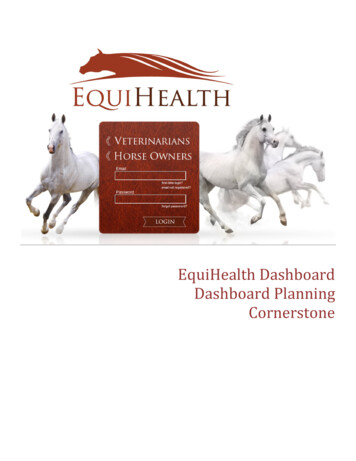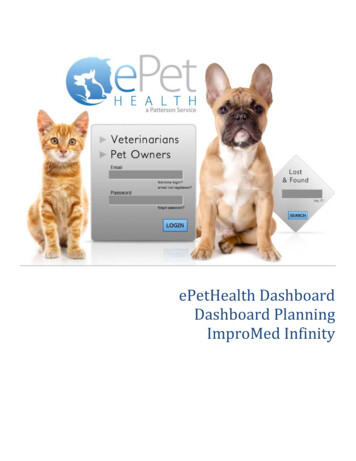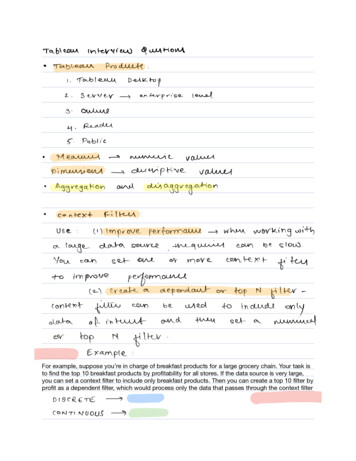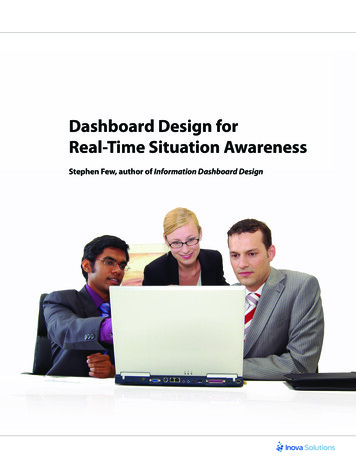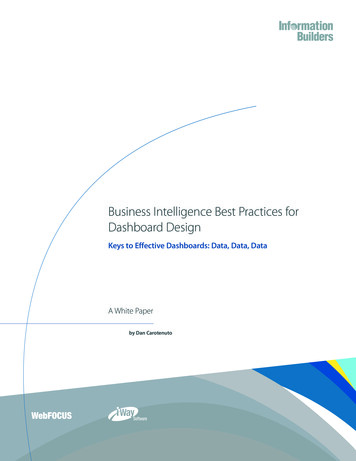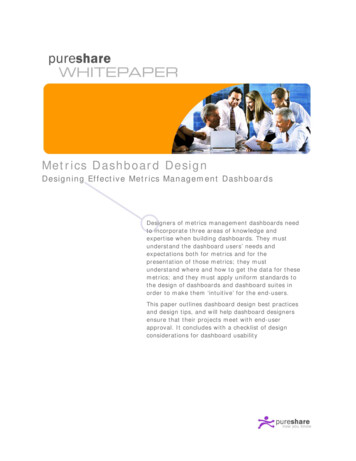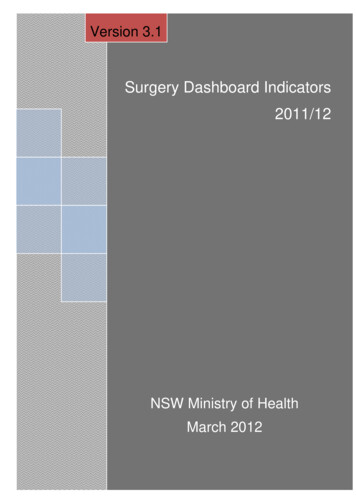
Transcription
Version 3.1Surgery Dashboard Indicators2011/12NSW Ministry of HealthMarch 20121
Further Information:This document supercedes Version 2.1c (2009) and replaces all previous versions ofthe Surgical KPI Dictionary/Surgery Dashboard Indicator definitions released by theHealth Services Performance Improvement Branch or Demand and PerformanceEvaluation BranchIf you have any queries/comments regarding the Performance Indicators, pleasecontact:Policy issues:Health Services Performance Improvement BranchData issues:Demand and Performance Evaluation BranchTrim Reference; H12/12496-3
Surgery Indicator Definitions 2012ContentsTable of ContentsWaiting Lists . 4Overdue Elective Surgery Patients . 4Elective Surgery Patients Admitted Within Clinically Appropriate Time . 6Elective Surgery Patients on the Waitlist Not Ready for Care . 8Operating Theatre . 10Elective Surgery Theatre Utilisation: Operating Room Occupancy . 10First Case On Time Theatre Performance . 12Number of Theatre Attendances . 14Surgical Separations . 16Cancellations on Day of Surgery . 18Day Of Surgery Cancellation Reasons . 21Emergency Theatre Access . 22Emergency Surgery Access . 22Admission . 25Day Of Surgery Admissions. 25Extended Day Only Performance for Targeted Procedures . 27Extended Day Only (EDO) Admission Policy Procedures . 29Page 3
Surgery Indicator Definitions 2012Waiting ListsWAITING LISTSOVERDUE ELECTIVE SURGERY PATIENTSCategory 1 Ready-for-care patients (RFC) 30 days (number) (9B5)INDICATOR: 9B5, 9B6 & 9B7Category 2 Ready-for-care patients (RFC) 90 days (number) (9B6)Category 3 Ready-for-care patients (RFC) 365 days (number) (9B7)Previously known as Overdue planned surgical patients on listVersion number6.1ScopeAll ready for care patients currently on the NSW Health Waiting TimesCollection for elective surgery.GoalTo reduce waiting time for elective surgery in public hospitals.Desired outcomeBetter management of waiting lists to minimise waiting time for electivesurgery.Primary point of collectionWaiting List/Booking ClerkData Collection Source/SystemPatient Admission System (PAS)/Waiting List Collection On–LineSystem (WLCOS)Primary data source foranalysisWLCOSIndicator definitionNumber of elective surgical patients on the NSW Health Waiting TimesCollection whose waiting time (last urgency waiting time for categories 1and 2, ready for care days for category 3) has exceeded the timerecommended in the clinical priority category to which they have beenassigned.Number of Category 1 patients waiting 30 daysNumber of Category 1 surgical patients who have been waiting forelective admission longer than 30 days.Number of Category 2 patients waiting 90 daysNumber of Category 2 surgical patients who have been waiting forelective admission longer than 90 days.Number of Category 3 patients waiting 365 daysNumber of Category 3 surgical patients who have been waiting forelective admission longer than 365 days.InclusionsReady for Care patients (clinical priority categories 1, 2 and 3) on thesurgical waiting list.ExclusionsNot Ready for Care (NRFC) patients are excluded (clinical prioritycategory 4).TargetsTarget0 (Zero) for Category 1 30 days0 (Zero) for Category 2 90 days0 (Zero) for Category 3 365 daysPage 4
Surgery Indicator Definitions 2012Waiting ListsCommentsPatients should be admitted within the timeframe recommended for theassigned clinical priority category:Category 1 Admission within 30 days desired for a condition that hasthe potential to deteriorate quickly to the point that may become anemergency.Category 2 Admission within 90 days desirable for a condition, which isnot likely to deteriorate quickly or become an emergency.Category 3 Admission within 365 days acceptable for a condition,which is unlikely to deteriorate quickly and which has little potential tobecome an emergency.ContextElective surgery: The numbers of overdue patients represent a measureof the hospital‟s performance of elective surgical care.Related Policies/ ProgramsClinical Services Redesign ProgramWaiting Time and Elective Surgery Policy 2012Useable data available fromJuly 1994Frequency of ReportingMonthlyTime lag to available dataReporting required by the 10th working day of each month, data availablefor previous monthBusiness ownersSystem Purchasing and Performance DivisionContact - PolicyDirector, Health Service Performance Improvement BranchContact - DataDirector, Demand and Performance Evaluation BranchRepresentationData typeNumericFormNumberLayoutNN,NNNMinimum size1Maximum size6Related National IndicatorPage 5
Surgery Indicator Definitions 2012Waiting ListsINDICATOR: S7ELECTIVE SURGERY PATIENTS ADMITTED WITHINCLINICALLY APPROPRIATE TIMEPercentage - %Previously known as “planned surgery patients admitted on time”Version number1.2ScopeAll elective surgery patients who are admitted and included in the NSWHealth Waiting Times CollectionGoalTo reduce waiting time for elective surgery in public hospitals.Desired outcomeBetter management of waiting lists to minimise waiting time for Electivesurgery.Primary point of collectionWaiting List/Booking List ClerkData Collection Source/SystemPatient Administration System (PAS)/Waiting List Collection On-LineSystem (WLCOS)Primary data source foranalysisWaiting List Collection System (WLCOS)Indicator definitionThe percentage (%) of elective surgery patients on the NSW HealthWaiting Times Collection who were admitted within the timeframerecommended for their clinical priority category.NumeratorNumerator definitionTotal number of elective surgery patients in the NSW Health WaitingTimes Collection who:Have been admitted for treatment within the reporting period, andwere admitted within the timeframe recommended for theirclinical priority category.Note: includes:o Staged patients *Refer to Policy for management ofstaged patientso Emergency admissions for their recorded waitlistprocedureNumerator sourceWLCOSNumerator availabilityAvailable MonthlyDenominatorDenominator definitionTotal number of surgical patients in the NSW Health Waiting TimesCollection who have been admitted for treatment within the reportingperiod.Denominator sourceWLCOSDenominator availabilityAvailable,InclusionsSurgical patients in the NSW Health Waiting Times Collection who havebeen admitted for treatment, that is where the reason for removal is1 Routine admissionPage 6
Surgery Indicator Definitions 2012Waiting Lists2.Emergency Admissions, where the patient has surgery for thewaitlisted procedure OR8 Admission contracted to a private hospital/day procedurecentreExclusionsTargetsPatients whose Waiting List Category is not „Elective SurgeryTarget based on the requirements for the National PartnershipAgreement are:Category 1Category 2 Category 3Baseline92.3%86.6%89.4%Jan 11 to 31 Dec 0%97.0%2015100%100.0%100%Source: Table A5, A6 & A7 National Elective Surgery Targets, National Health ReformAgreementContextTo ensure timely access for Elective Surgery to achieve the NationalElective Surgery targets (NEST) as outlined in the National PerformanceAgreement (NPA).Useable data available fromJuly 2005Frequency of ReportingMonthly/WeeklyTime lag to available dataReporting required by the 10th day of each month, data available forprevious monthBusiness ownersSystem Purchasing and Performance DivisionContact - PolicyHealth Service Performance Improvement BranchContact - DataDemand and Performance Evaluation BranchRepresentationData typeNumericFormNumber, presented as a percentage (%)Representational layoutNNN.NNMinimum size3Maximum size6Date effective1July 2008Related National IndicatorPI 34-Waiting times for elective surgery, itemId/421623Meteor ID 421623Page 7
Surgery Indicator Definitions 2012Waiting ListsIndicator S11Version numberScopeGoalDesired outcomeData Collection Source/sPrimary data source foranalysisDefinitionELECTIVE SURGERY PATIENTS ON THE WAITLIST NOTREADY FOR CARE1.0All elective surgery patients currently on a waiting list collection for electivesurgery.To reduce waiting time for elective surgery in public hospitals.Better management of waiting lists to minimise waiting time for electivesurgery.Waiting List ClerkPatient Admission System (PAS)/Waiting List Collection On-Line System(WLCOS)The percentage of elective patients booked on a waiting list collection forelective surgery who are recorded as “Not Ready for Care”A Not Ready for Care patient is defined as a patient who is not available tobe admitted to hospital until some future date, and is either:staged-deferred -not ready for clinical reasonsnot ready for personal reasonsResults should be reported separately for deferred and staged patients.Note: Target applies to deferred patients only.NumeratorNumerator definitionTotal number of booked elective surgery patients on the waiting listcollection who are recorded as Not Ready for Care for elective surgery.Numerator sourceNumerator availabilityDenominatorDenominator definitionPAS/WLCOSAvailableDenominator sourceDenominator availabilityInclusionsExclusionReportingReporting required byIndicators reported toNext report duePAS/WLCOSAvailableAll Not Ready for Care elective surgical patients on the waitlist collectionNon surgical patients on the WaitlistThe number of elective surgical patients on the waiting list collection forelective surgery.NSW HealthSurgical Services TaskforceOngoing, MonthlyPage 8
Surgery Indicator Definitions 2012Waiting ListsTargetsContextRelated Policies/ Programs5% applied to deferred category and10% for Total Not Ready for Care PatientsBusiness ownersContact - PolicyContact - DataClinical Services Redesign ProgramWaiting Time and Elective Surgery Policy 2012July 2007MonthlyReporting required by the 10th working day of each month, data available forprevious month.System Purchasing and Performance DivisionDirector, Health Service Performance Improvement BranchDirector, Demand and Performance Evaluation BranchRepresentationData typeFormRepresentational layoutMinimum sizeMaximum sizeNumericNumber, presented as a percentage (%)NNN.N35Useable data available fromFrequency of ReportingTime lag to available dataPage 9
Surgery Indicator Definitions 2012Operating TheatreOPERATING THEATREINDICATOR: 9C7ELECTIVE SURGERY THEATRE UTILISATION:OPERATING ROOM OCCUPANCYVersion numberTheatre Utilisation For Elective Sessions measured as operating roomoccupancy, Previously known as “planned surgery utilisation”ScopePatients treated in dedicated elective theatre sessions.GoalMaximise the productivity of operating theatres in hospitals, reducecancellations and improve the flow of patients through the hospital.Desired outcomeEfficient access and throughput for emergency and elective surgerypatients and reduction in waiting lists.Primary point of collectionOperating TheatresData Collection Source/SystemPatient Administration System (PAS), Operating Theatre Systems egSurgiNet, Manual Collection.Primary data sourceProvided directly by LHDs and Networks to Ministry of Health.Indicator definitionThe percentage of time allocated to elective theatre sessions where theoperating theatre (operating room) was occupied by surgery patientsreceiving active treatment.1.1NumeratorNumerator definitionThe sum of ([Patient out of operating theatre/operating roomroom date/time] – [Patient in (operating theatre/operating room)date/time]) for all patients treated during an elective theatre session.Note:When a patient enters the operating theatre/operating room (withinthe Theatre suite) before the session start time, the actual sessionstart time should be treated as the [patient in room date/time] forthis indicator.The time spent in the theatre suite but not in the operatingtheatre/operating room before the session start time is considered“out-of-session” time.Patient in room time commences when the patient physically entersthe operating theatre/operating room assigned to the electivesession. This applies even when an anaesthetic or other procedureis commenced prior to the patient entering in the operatingtheatre/operating room.Similarly, when a patient leaves the theatre operating room after theallocated session end time, the session end time should be treatedas the [patient out of room date/time] for this indicator. (The timespent in the theatre after the session end time is considered “out-ofsession” time.)Numerator sourceOperating Theatre SystemNumerator availabilityVariable across sitesPage10
Surgery Indicator Definitions 2012Operating TheatreDenominatorDenominator definitionThe time allocated to elective theatre sessions.Denominator sourceOperating theatre data collectionDenominator availabilityVariable across sitesInclusionsSurgical patients treated in operating theatres during elective sessions.ExclusionsTargetsSurgery performed outside elective surgery sessions.Periods of anaesthesia that occurred outside the operatingroom allocated to the session.80%CommentsContextThis indicator is intended as a measure of operatingtheatre/operating room use during sessions routinely allocated forelective surgery only. Activity performed outside of the operatingtheatre/operating room and these sessions is not included in theindicator.The indicator specifically relates to the time the patient is physicallyin the operating theatre/operating room, if the patient isanaesthetised outside the actual operating theatre/operating room,(e.g. in the anaesthetic bay/room) before the patient enters thetheatre, the time is NOT counted towards utilisation of the session.In order to estimate operating theatre productivity and efficiency, anumber of performance indicators are required. Surgery cannot beperformed without a number of support activities, which need to beviewed in combination for a true picture of utilisation to be obtained.Operating theatre/operating room, occupancy during elective sessionhours is just one of a number of indicators of theatre utilisation.Related Policies/ ProgramsClinical Services Redesign ProgramWaiting Time and Elective Surgery Policy 2012Useable data available fromVariable across site. State-wide collection commenced June 2006Frequency of ReportingMonthlyTime lag to available dataReporting required by the 10th working day of each month, dataavailable for previous monthBusiness ownersSystem Purchasing and Performance DivisionContact - PolicyDirector, Health Service Performance Improvement BranchContact - DataDirector, Demand and Performance Evaluation BranchRepresentationData typeNumericFormNumber, presented as a percentage (%)Representational layoutNNN.NMinimum size3Maximum size5Page11
Surgery Indicator Definitions 2012Operating TheatreIndicator S8FIRST CASE ON TIME THEATRE PERFORMANCE1.1Version numberScopeTheatre sessionsGoalBetter monitoring and continuous improvement of theatre resources.Desired outcomeShorter waiting times for elective non-emergency care. Betterforecasting utilisation and management of surgical activity in operatingtheatres.Data Collection Source/sOperating theatresPrimary data source for analysis Operating Theatre Information System e.g. SurgiNet, Manual.DefinitionThe percentage of theatre sessions where the first case done in thesession is commenced at (or before) the session start time.NumeratorNumerator definitionNumber of theatre sessions where the “patient in room (operatingtheatre/operating room,) time” for the first case is equal to or beforethe scheduled start time for the sessionPatient in room time commences when the patient physicallyenters the operating theatre/operating room, assigned to thesession. This applies even when an anaesthetic or otherprocedure is commenced prior to the patient entering in theoperating/theatre room.Numerator sourceOperating Theatre Information Systems, ManualNumerator availabilityVariable across sitesDenominatorDenominator definitionTotal number of theatre sessions for the periodDenominator sourceOperating Theatre Information Systems, ManualDenominator availabilityVariable across sitesInclusionsTheatre sessions occurring in the reporting periodExclusionsPlanned emergency sessionsReportingReporting required byClinical Services Redesign ProgramWaiting Time and Elective Surgery Policy 2012Indicators reported toSurgical Services TaskforceTargetsTarget95%Page12
Surgery Indicator Definitions 2012Operating TheatreCommentsIf the “in room time” occurs earlier than the scheduled sessiontime it is also considered “on time”.Except in an emergency, the patient should not enter theoperating theatre/operating room, until such time as the nursingstaff are ready for the patient to enter the room, active patient carewill commence immediately after entry into the room (includingmoving the patient onto the operating table and anaestheticpreparation), and that the surgical team are available to start theplanned procedure without delay.ContextUseable data available from2008Frequency of ReportingMonthlyTime lag to available dataReporting required by the 12th calendar day of each month, dataavailable for previous monthBusiness ownersSystem Purchasing and Performance DivisionContact - PolicyDirector, Health System Performance Improvement BranchContact - DataDirector, Demand and Performance Evaluation BranchRepresentationData typeNumericFormNumber, presented as a percentage (%)Representational layoutNNN.NMinimum size3Maximum size5Date effective1 July 2008Page13
Surgery Indicator Definitions 2012Operating TheatreIndicator S6NUMBER OF THEATRE ATTENDANCESVersion number4.8ScopePatients treated in an Operating TheatreGoalShorter waiting times for elective non-emergency care, Bettermonitoring and continuous improvement of theatre resources.Desired outcomeBetter forecasting utilisation and management of surgical activity inoperating theatres.Primary point of collectionOperating theatresData Collection Source/sOperating Theatre Information System, Manual, PatientAdministration System (PAS)Primary data source for analysisHIEDefinitionNumber of theatre attendances where the commencement time waswithin the reporting period.Where:Each discrete theatre attendance by a patient is counted as oneattendance, irrespective of the number of proceduresperformed during that attendance.Where a theatre attendance continues past midnight, theattendance is counted in the day it commenced.Data SourceOperating Theatre Information SystemData AvailabilityVariable at sitesInclusionsAll emergency and elective theatre attendances for surgery, othertherapeutic procedures or other medical intervention e.g. dentalextraction in children.ExclusionsNilReportingIndicators reported toSurgical Services TaskforceTargetsContextRelated Policies/ProgramsClinical Services R
emergency. Category 2 Admission within 90 days desirable for a condition, which is not likely to deteriorate quickly or become an emergency. Category 3 Admission within 365 days acceptable for a condition, which is unlikely to deteriorate quickly and which has
